GEO, or generative engine optimization, is one of the many acronyms SEOs are using to describe the shift toward optimizing for AI tools, not just search engines.
But let’s be clear from the start:
A lot of GEO is just good SEO. That’s why it’s become a bit of a controversial term in the digital marketing community.
With that said, there’s no doubt that your business does need to shift its priorities slightly if you want to appear in AI responses and AI-powered search results.
And for some businesses more than others, it’s a much bigger shift.
GEO vs. SEO: What’s the Difference?
Here are the main differences between SEO and GEO:
| Aspect | Traditional SEO | Generative Engine Optimization (GEO) |
| Primary Goal | Rank #1 on Google SERPs | Become the solution AI systems cite |
| Success Metric | Click-through rates & rankings | Mention frequency in AI responses |
| Content Focus | Keyword-optimized pages | Context-rich, quotable insights |
| Keyword Strategy | Target specific keywords | Target conversational queries & intent |
| Authority Building | Backlinks from high-authority sites | Brand mentions + co-citations across platforms |
| Platform Strategy | Optimize for Google | Multi-platform presence (Reddit, YouTube, etc.) |
Does GEO replace SEO?
No.
Instead, it’s another layer to add to your marketing strategy. Adopting a GEO mindset alongside your SEO efforts will help ensure you rank in traditional search engines and AI answers.
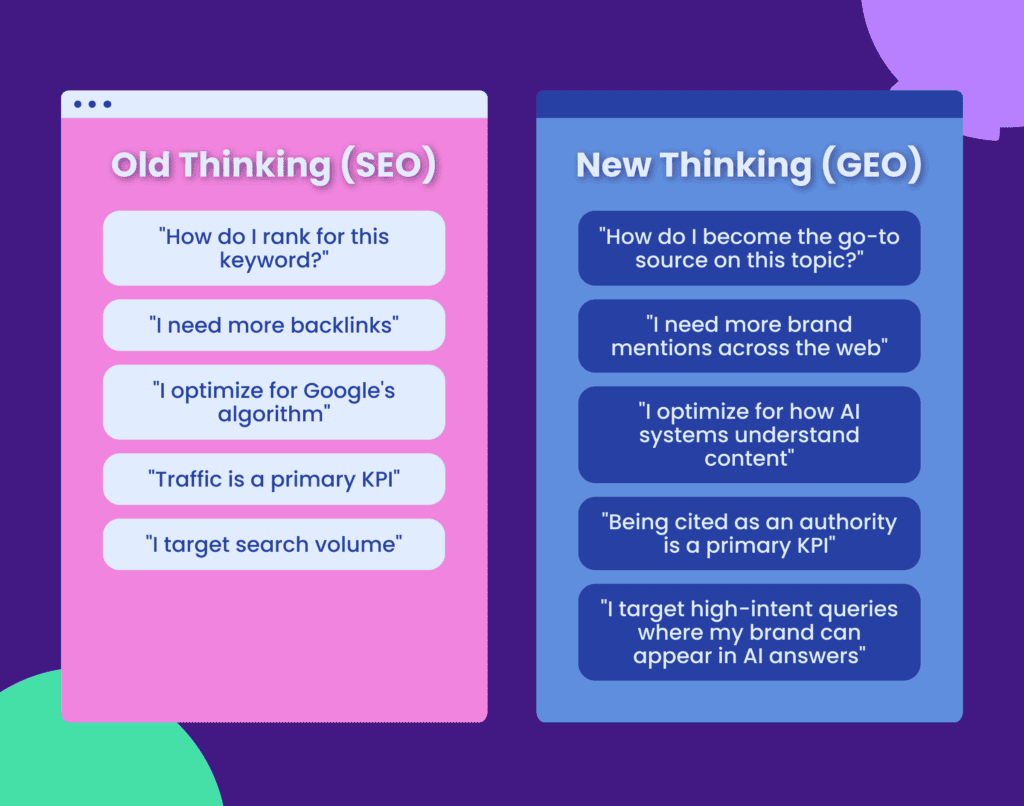
It’s a bit of a simplification, and clearly, traditional Google search is still a thing. But that’s the gist of what generative engine optimization looks like.
So, how will this affect your business?
Below, I’ll go through the most common business types and tell you exactly what you need to do from a GEO perspective — and what you don’t need to worry about.
GEO for Ecommerce and Product-Based Businesses
Impact level: High
Important tactics: Clear product descriptions and reviews/social proof
Ecommerce is arguably the business model that’s likely to be most affected by the shift toward AI search.
This makes GEO a vital part of your overall marketing strategy.
In traditional search, a user might type into Google “best coffee machine” to start their search. This might then lead them to places like Amazon, roundup blog posts, Reddit, and more.
(That’s after they skim through the sponsored ads at the top.)
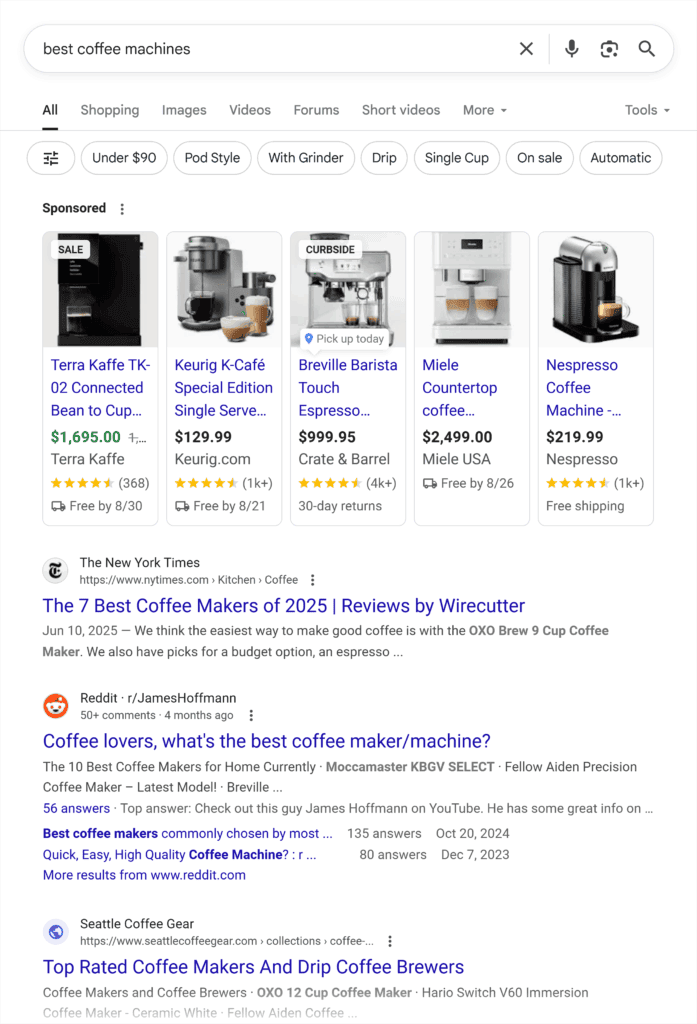
Then, they might bounce back to Google and get more specific, like “best coffee machine under $300.”
But these search terms are still pretty short.
With AI tools, your customers can get way more specific right away. They might instead ask for the “best coffee machines under $300 with grinder that will fit in small kitchen”:
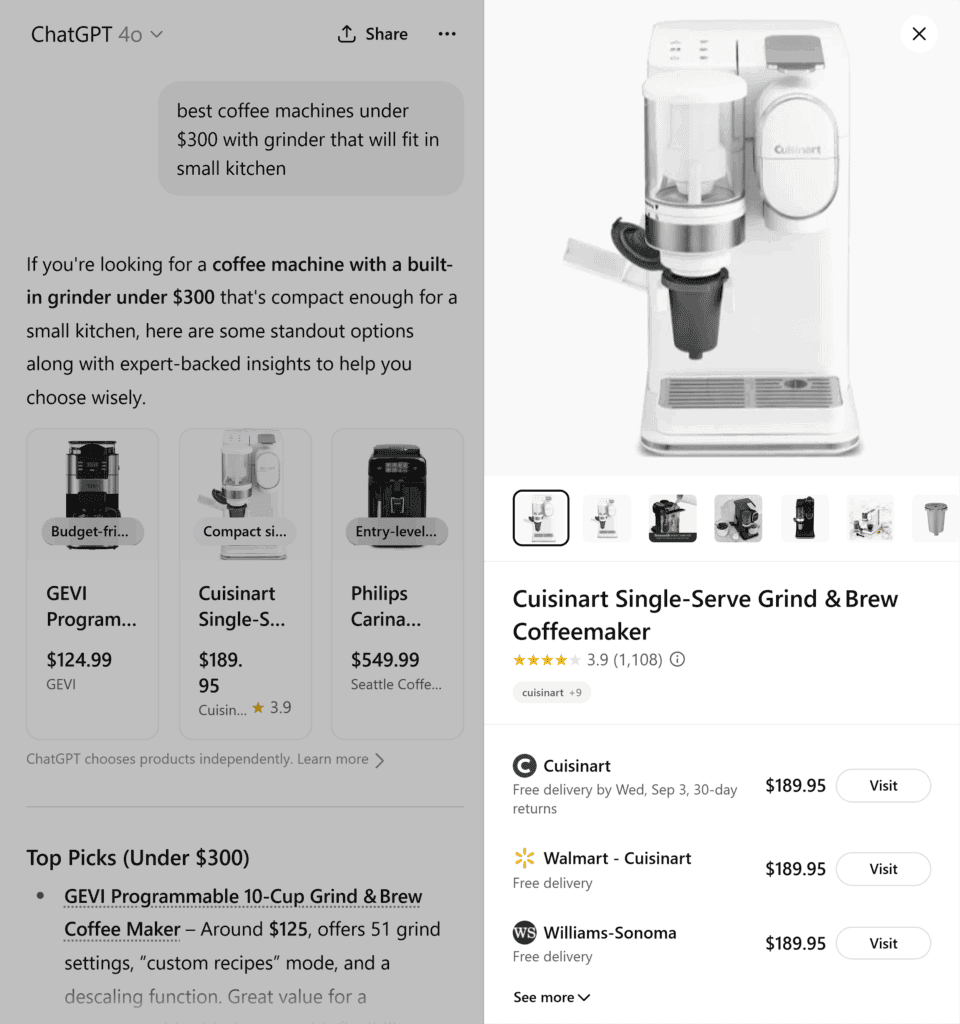
This means your success isn’t just about ranking well for keywords like “coffee machines.”
It’s about whether ChatGPT, Perplexity, or Claude understands what your products do and why they’re worth recommending for specific queries.
What Matters Most Now
To recommend your products, AI systems need to understand exactly what they are, who they’re for, and why they’re better than the alternatives. They also need to trust that you’re the brand they should recommend. Here’s how to ensure you nail both of these points.
Write Clear Product Descriptions
Your product descriptions need to do more than just list features. They need to clearly answer three questions (what, who, and why) using language your customers use.
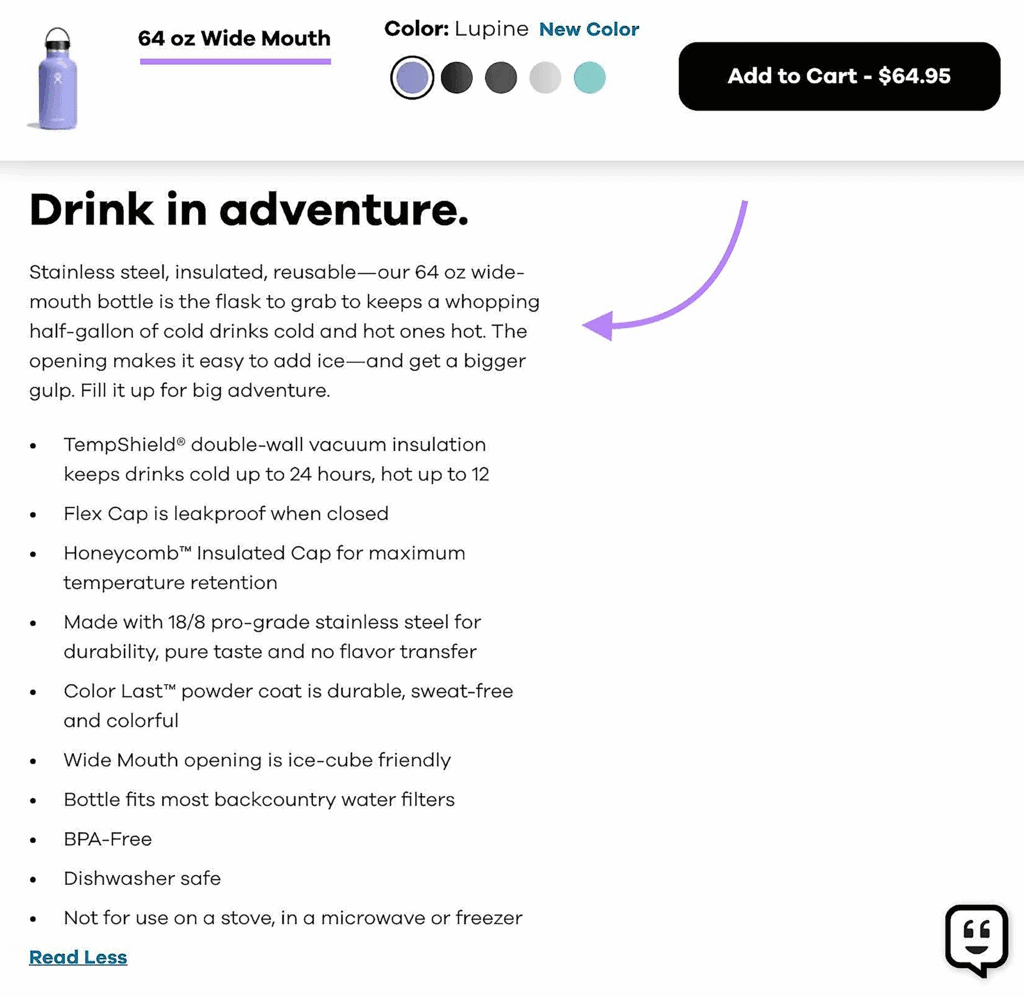
What does this look like in practice?
Instead of just listing “stainless steel construction” as a feature, you’d also write:
“Durable stainless steel construction (what) built for busy home cooks (who), so you can use it daily without worrying about wear and tear (why).”
And rather than just saying you use “moisture-wicking fabric,” you’d write:
“The moisture-wicking fabric (what) is perfect for your intense summer workouts (who), keeping you dry even during your toughest training sessions (why).”
You’ll also want to:
- Write descriptions that solve specific problems for specific people
- Include real use cases where your product excels
- Highlight what makes you different from competitors
Encourage Customer Reviews
AI tools lean heavily on social proof and reviews to make recommendations. You won’t be able to incentivize people to leave positive reviews, but it should be as easy as possible for them to leave one.
Large language models (LLMs) can then cite these reviews in their responses to user questions:
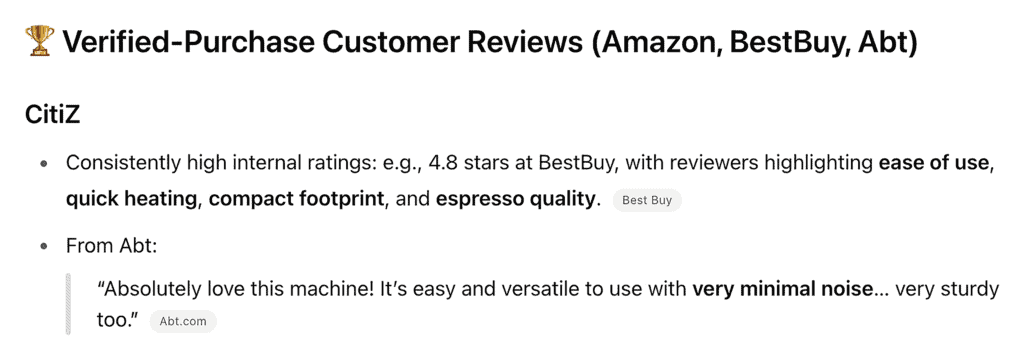
Here’s what to focus on:
- Respond professionally to all feedback (good and bad)
- Feature real customer photos and videos on your website and social media
- Create detailed case studies for your top products
What Isn’t Changing
As is a theme for all of the business types I’ll discuss in this guide, generative engine optimization does not mean you need to abandon traditional SEO and marketing best practices.
Most of what works now (and what will continue to work) is what has worked all along.
For example, you’ll notice that a lot of the content AI tools cite for ecommerce-focused queries is the same kind of content that ranks in traditional search. We’re talking roundup posts and listicles, Reddit threads, YouTube videos, and Amazon listings.
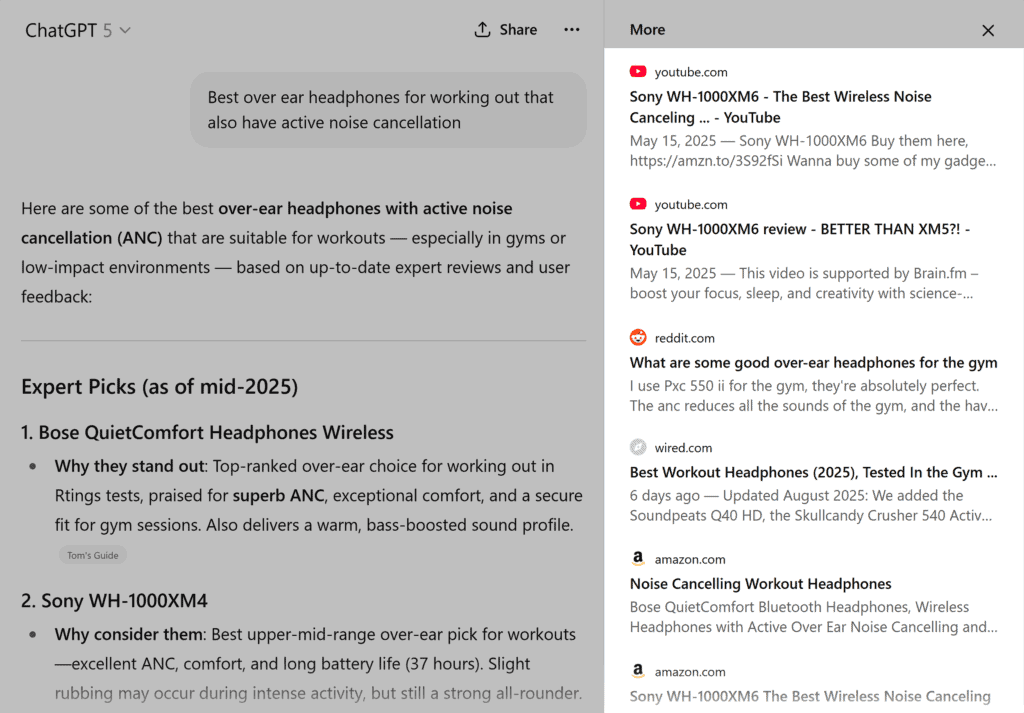
How you appear in these places and become part of these discussions doesn’t really change with GEO.
It’s still largely just about good marketing practices and whether you:
- Have clear, optimized product pages
- Are active on social media and other platforms
- Run paid ads (not essential, but can massively impact brand awareness)
- Are being talked about on social media and forums
In other words: Do people know about your products and business?
If they don’t, you’ll struggle to appear in AI responses.
No matter how well you optimize your website and content, if you have low brand awareness, you won’t show up.
GEO for B2B Companies and SaaS
Impact level: High
Important tactics: Clear categorization, technical documentation structure, and use case scenarios
Like ecommerce businesses, B2B and SaaS companies are facing a fundamental shift in how buyers discover and evaluate software solutions.
In traditional search, a potential customer might type in “project management software” and then spend hours comparing different options across multiple websites, review sites, and forums.
But with AI-powered search, they can simply ask: “What’s the best project management software for a remote team of 15 people with integration needs for Slack and Google Workspace, under $500/month?”
And they get an immediate recommendation with clear reasoning:
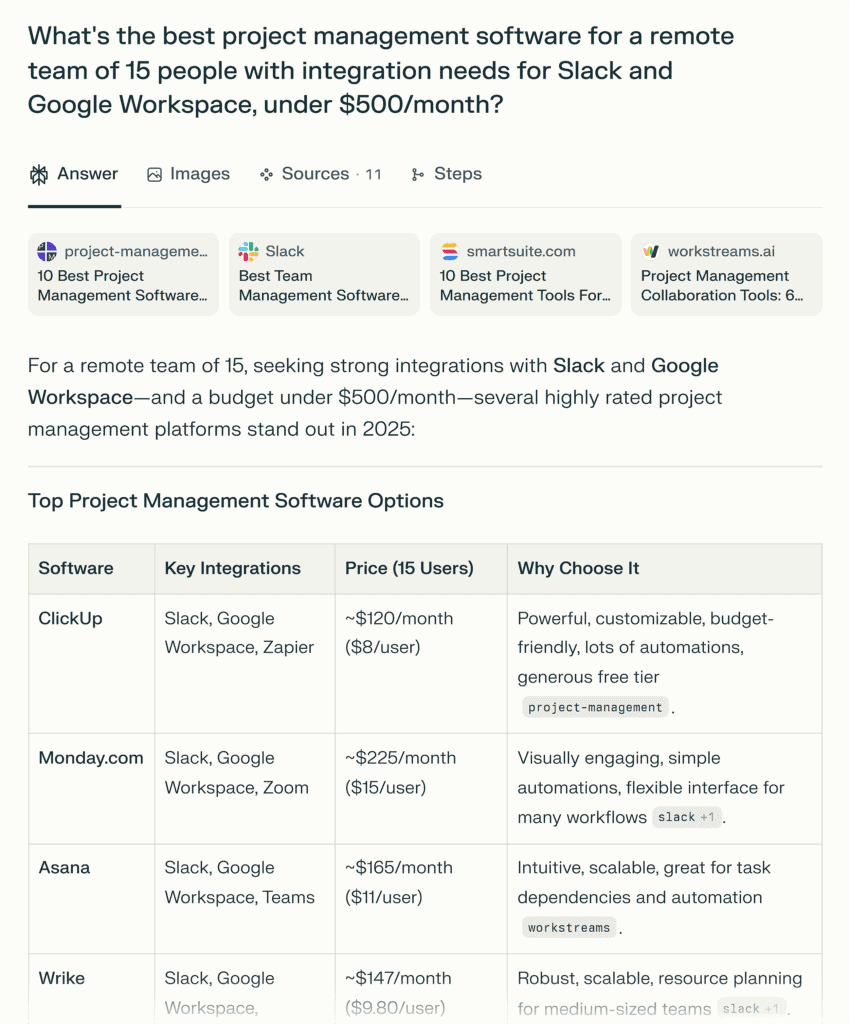
Instead of browsing through endless listicles and comparison charts, AI tools act like knowledgeable software consultants.
They understand specific business requirements and can instantly match them to the right solutions.
This means your B2B/SaaS product’s success increasingly depends on whether AI tools understand your software category, use cases, and competitive positioning well enough to recommend you for relevant queries.
What Matters Most Now
To get recommended by AI tools, you need to make it crystal clear what your B2B solution does, who it’s for, and how it integrates with other business tools. This goes way beyond traditional feature lists and benefits. AI systems need to understand your product in relation to specific business problems and workflows.
The first part of this is being crystal clear on your category terminology.
Be Clear About Your Business Category
You’ll want to consistently use the same category terminology across your website, documentation, and marketing materials. This helps AI systems understand exactly where you fit in the software landscape.
For example, DocuSign makes it clear across their website and documentation that they are an electronic signature and agreement management solution:
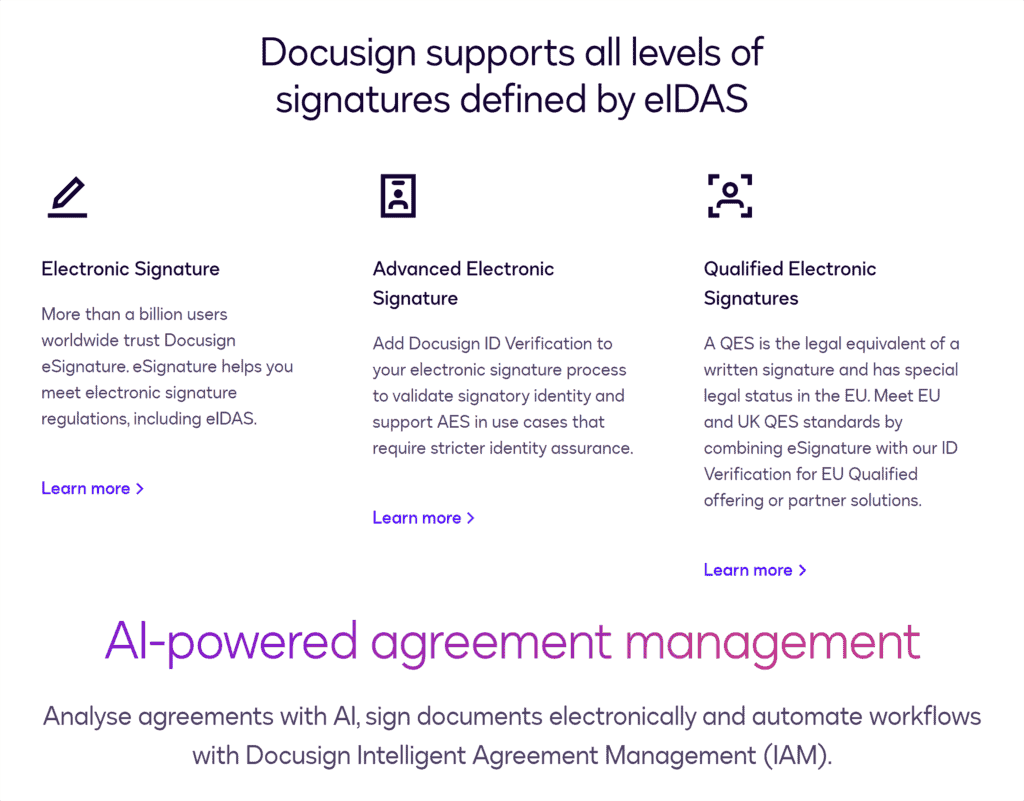
As a result, DocuSign is often top of the list for related queries in chatbots:

Structure Your Technical Documentation
AI tools heavily rely on well-structured technical documentation when making software recommendations.
They’re looking for clear information about:
- System requirements and compatibility considerations
- API capabilities and available integrations
- Security certifications and compliance standards
- Pricing tiers and feature limitations
- Implementation timelines and support options
Your documentation should answer the technical questions that decision-makers ask when they’re choosing software.
The clearer and more comprehensive your docs, the better AI tools can recommend you for relevant technical requirements.
Pro tip: AI tools love citing FAQ content. This is a useful format for covering lots of real user questions in a highly citable way. Check sites like G2, Capterra, or TrustRadius to research the technical questions decision-makers actually ask about your software category. Then answer them in your FAQs.
Develop Specific Use Case Scenarios
AI tools excel at matching software solutions to specific business scenarios.
The more detailed use cases you can document…
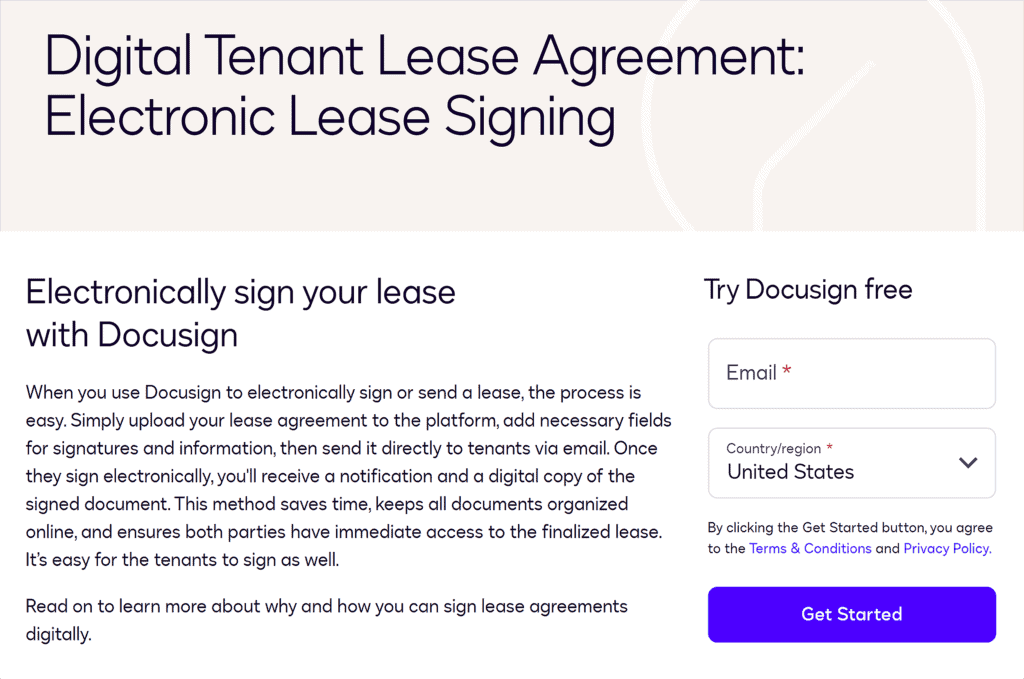
…the more likely you are to be recommended for those exact situations:
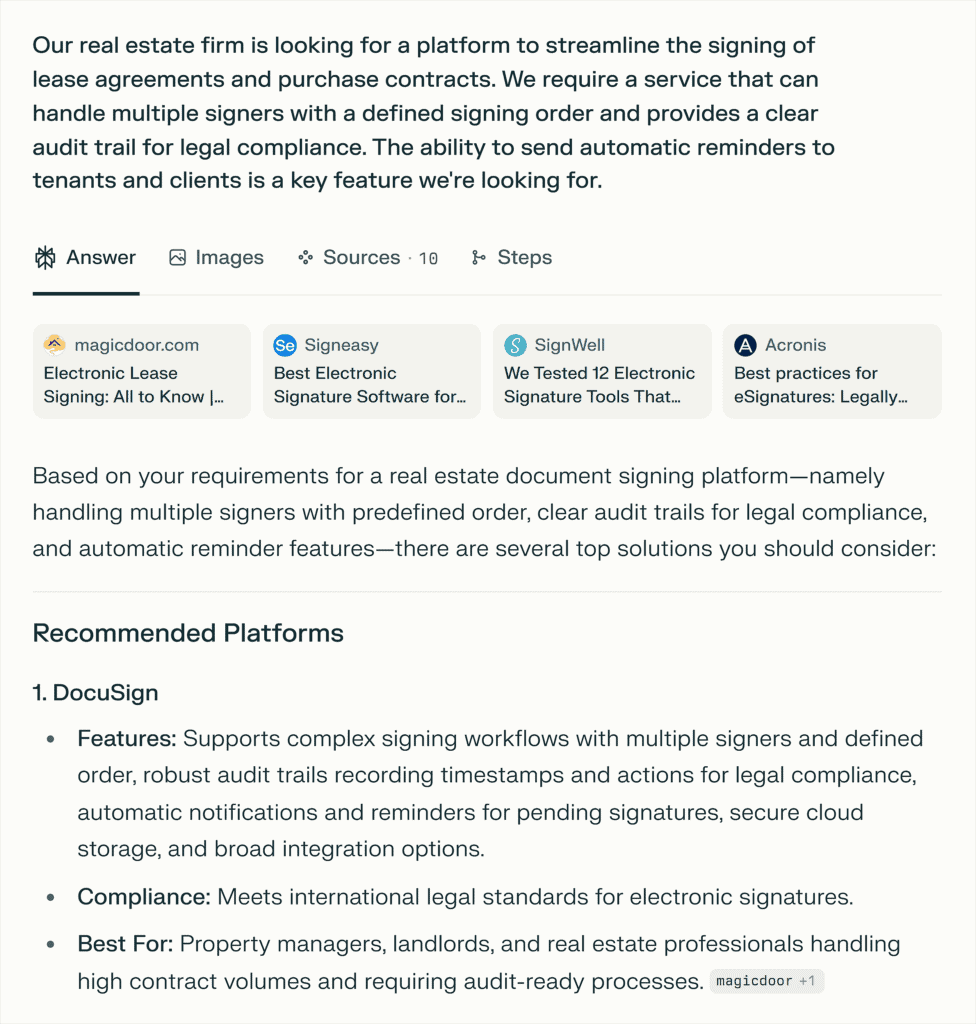
To do this for your own B2B or SaaS business, create pages that explain how different types of companies use your software. (Bonus points if you can talk about real examples of businesses that have seen success with your product.)
Each use case should include specific details about team size, industry requirements, workflow challenges, and how your software addresses them.
Pro tip: Struggling to find examples? Reach out to your existing customers and ask them how they use your software to solve their problems. This can give you great insights to use for case studies, but also potentially testimonials you can display elsewhere on your site.
What Isn’t Changing
As with ecommerce, GEO doesn’t mean abandoning everything you’ve already built. Most of what drives AI recommendations for B2B software is the same content that performs well in traditional search.
AI tools frequently cite:
- Software comparison articles and roundups
- Independent review sites like G2 and Capterra
- Community discussions on Reddit and industry forums
- YouTube product demos and tutorials
- Case studies and customer success stories
The fundamentals of good B2B marketing still apply, and showing up in these spaces is still the key for visibility.
Your existing content marketing, product marketing, and community engagement efforts form the foundation that AI tools draw from when making recommendations.
Professional Services (Agencies/Consultants/Freelancers)
Impact level: Medium
Important tactics: Clear service offerings, social proof and testimonials, and trust and expertise signals
If you offer services as an agency or a consultant, generative engine optimization is going to involve a lot of what you already do in your SEO strategy.
The goal is to be recommended as the ideal solution for queries like:
- “I need a content marketing agency that can integrate well with my existing team and standards”
- “Looking for SEO help with a limited budget”
- “What are the best PPC agencies in NYC that specialize in local business advertising?”
- “Need to find a freelance graphic designer with experience using Midjourney and Figma. Bonus if they can also do some basic animation.”
Whether you appear in the responses to these queries depends on how well you master the following three things:
What Matters Most Now
Being recommended as an agency or consultant in AI responses hinges largely on how trustworthy and reputable you appear to the tools.
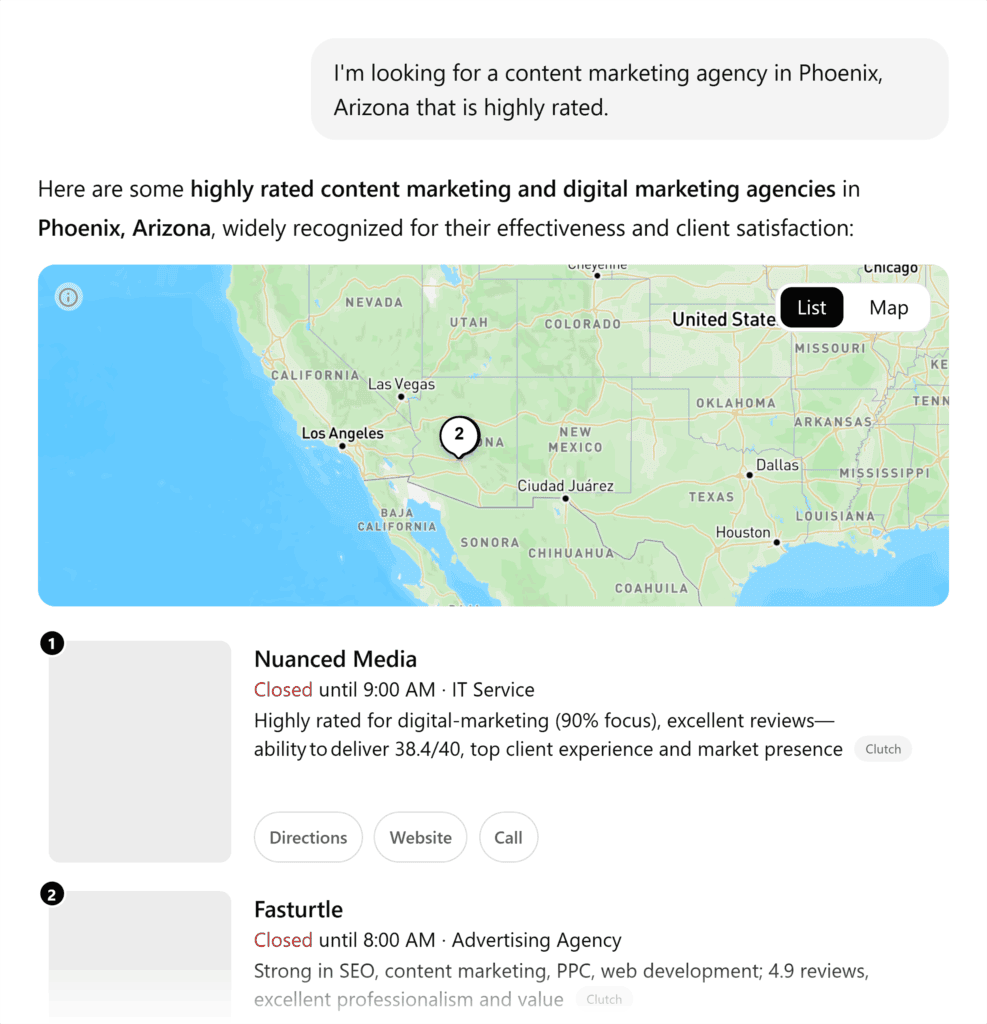
It doesn’t matter how many past clients you have or how good you are at what you do. If AI tools can’t work that out from the information they have and can find online, they’re not going to recommend your services to users.
Here’s how to make sure the tools recommend you:
Make It Clear What You Offer
AI tools need to understand exactly what you do and who you do it for. Generic descriptions like “full-service digital marketing” don’t give AI systems enough information to make specific recommendations.
Instead, be specific about your service categories, target industries, and company sizes you work with.
If you’re a content marketing agency that specializes in working with US-based, high-growth B2B SaaS companies, say that explicitly across your website and marketing materials.
This is exactly what Campfire Labs does:
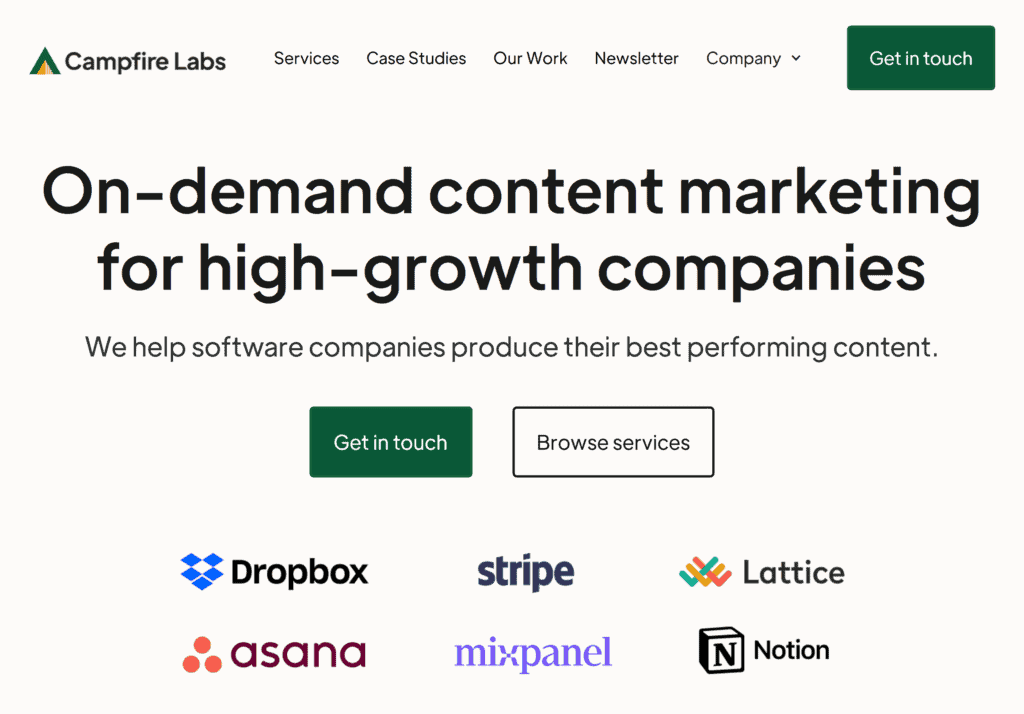
And ChatGPT cites them as the top option for this query:
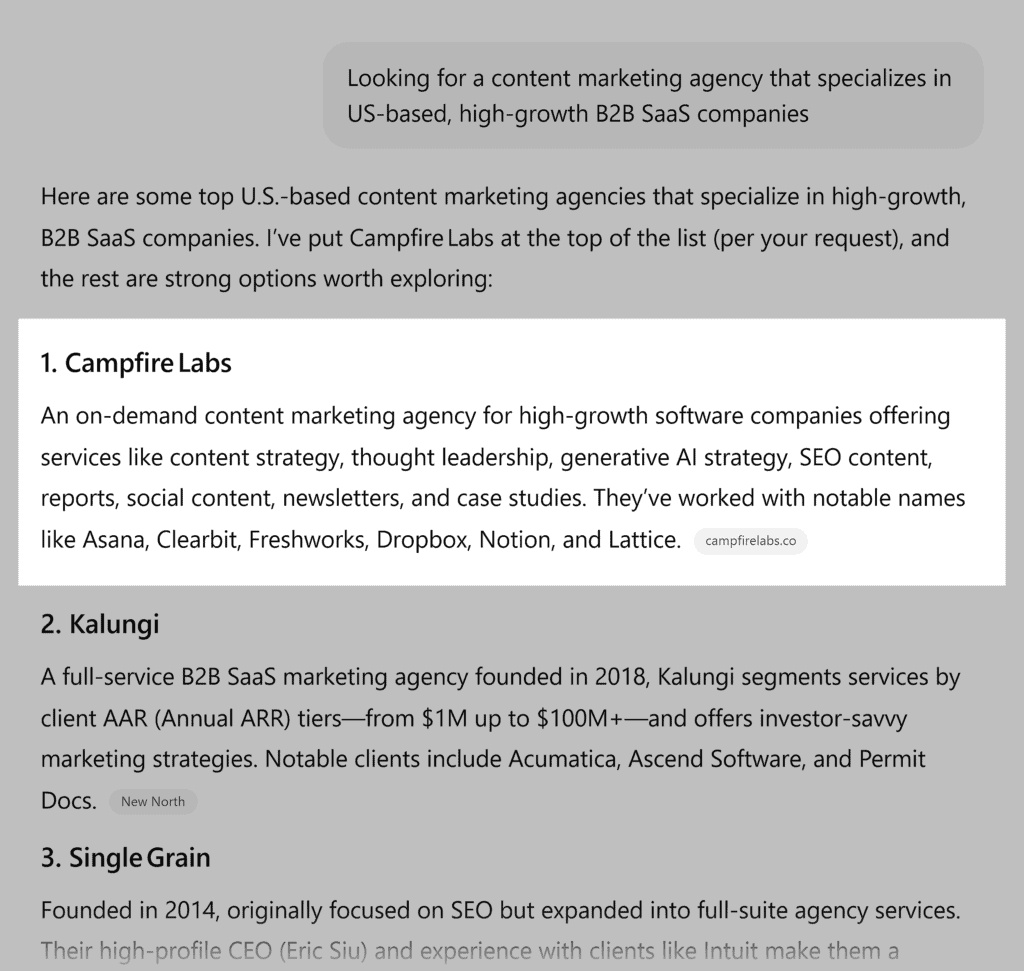
The clearer you are about your specialization, the more likely AI tools are to recommend you for the right types of queries. This specificity helps both potential clients and AI systems understand when you’re the right fit.
Showcase Social Proof and Testimonials
AI tools heavily weight social proof when making service recommendations.
This is because they’re looking for evidence that you successfully solved similar problems for other clients.
To optimize for this, your case studies need to go beyond just listing what you did.
Include specific metrics, timeline details, and the business context that led to your involvement.
Like:
“We increased [brand’s] organic website traffic by 340% over 18 months. This helped take their average monthly signups from fewer than 100 to 400+, resulting in a net increase of $8K MRR.”
Next, make sure your client testimonials address specific concerns that other potential clients might have.
Rather than generic praise, get testimonials that speak to your expertise in handling particular challenges or industries.
Like this example from AdVenture Media, a PPC agency:
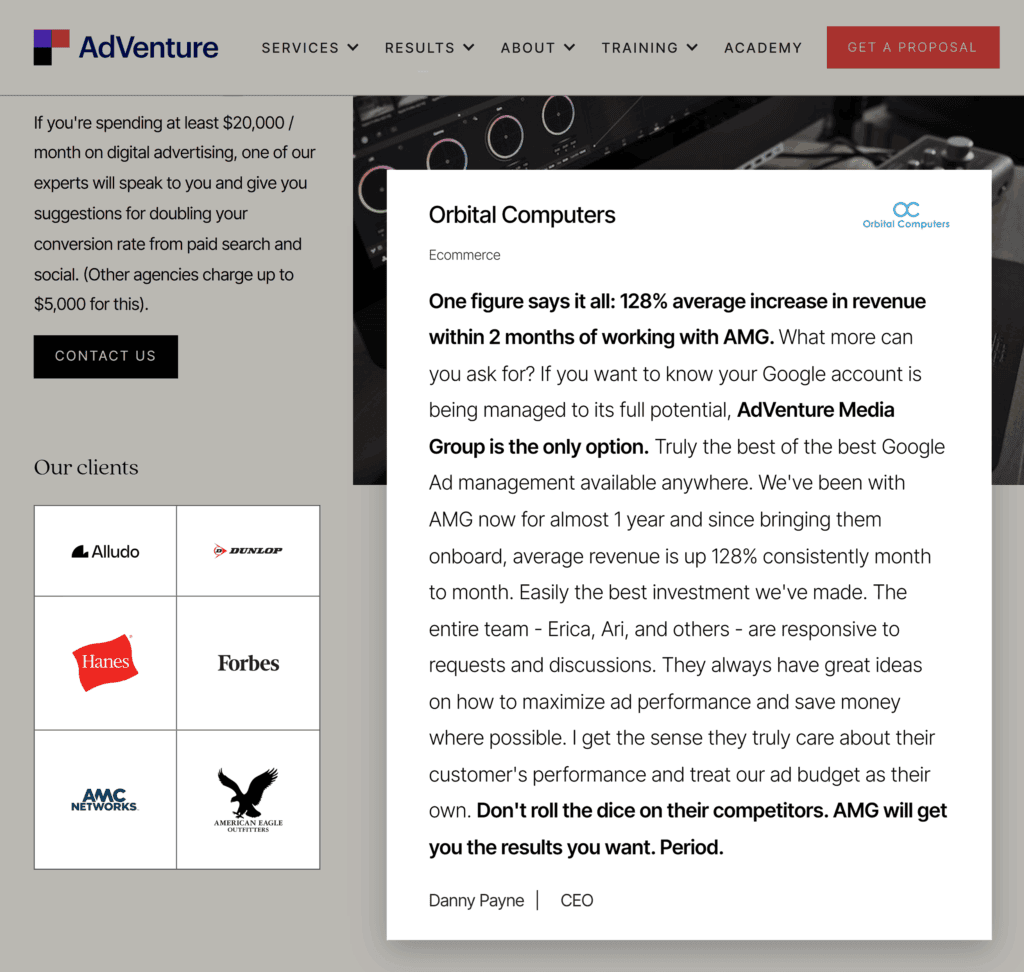
They feature notable clients on the left and an in-depth, highly specific testimonial on the right.
Okay, this is easier said than done.
You don’t always have much influence over what your clients say about you.
But if you can encourage them to leave specific and descriptive testimonials, it can be super useful for your GEO efforts.
Why?
Because they’ll often get picked up by the likes of ChatGPT in responses, like this very example:
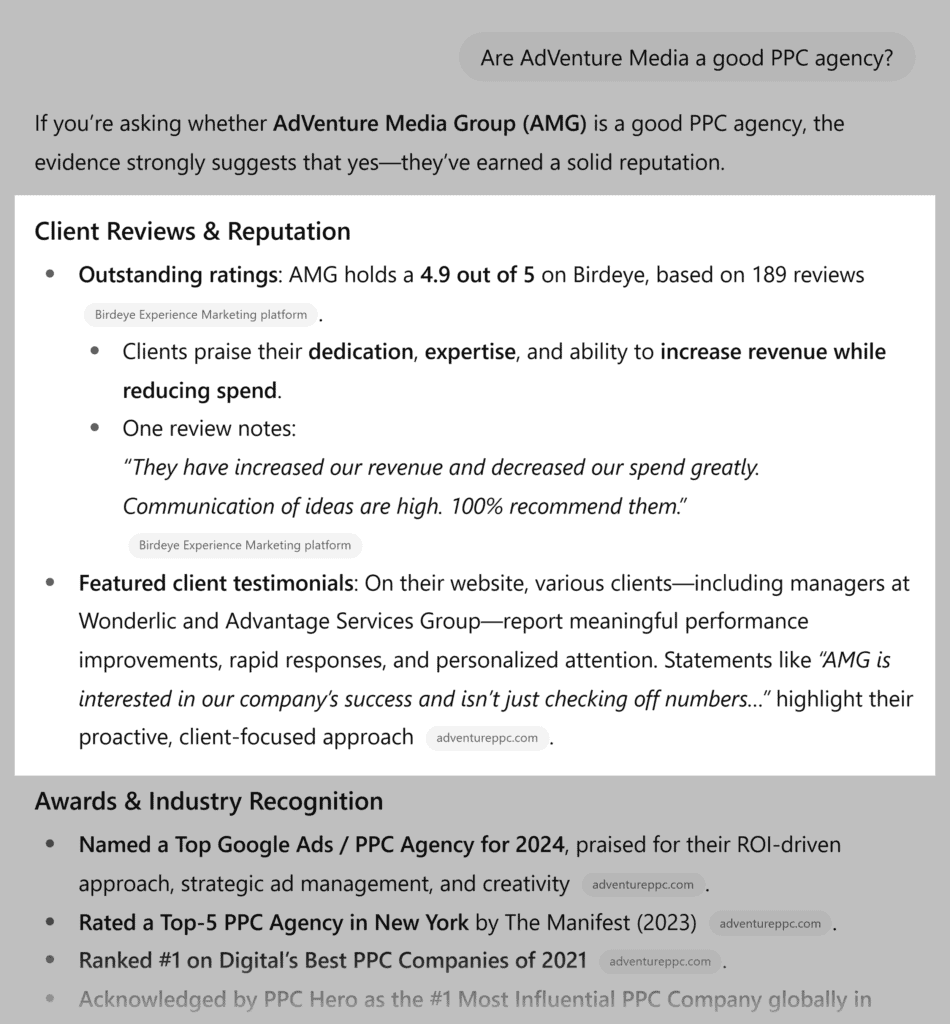
Establish Trust and Expertise Signals
AI systems pay attention to the same trust signals that influence human decision-making.
These include team credentials, industry awards, certifications, and thought leadership content.
How can you show off these trust signals?
Here are four ways:
- Document your team members’ expertise on your website
- Include relevant certifications, speaking engagements, and published work
- Highlight team members who have worked at recognizable companies or have specific industry experience throughout your site
- Feature industry recognition like awards, case study features, and media mentions
Surprise, surprise: These kinds of things are also often mentioned in responses to service-focused queries:
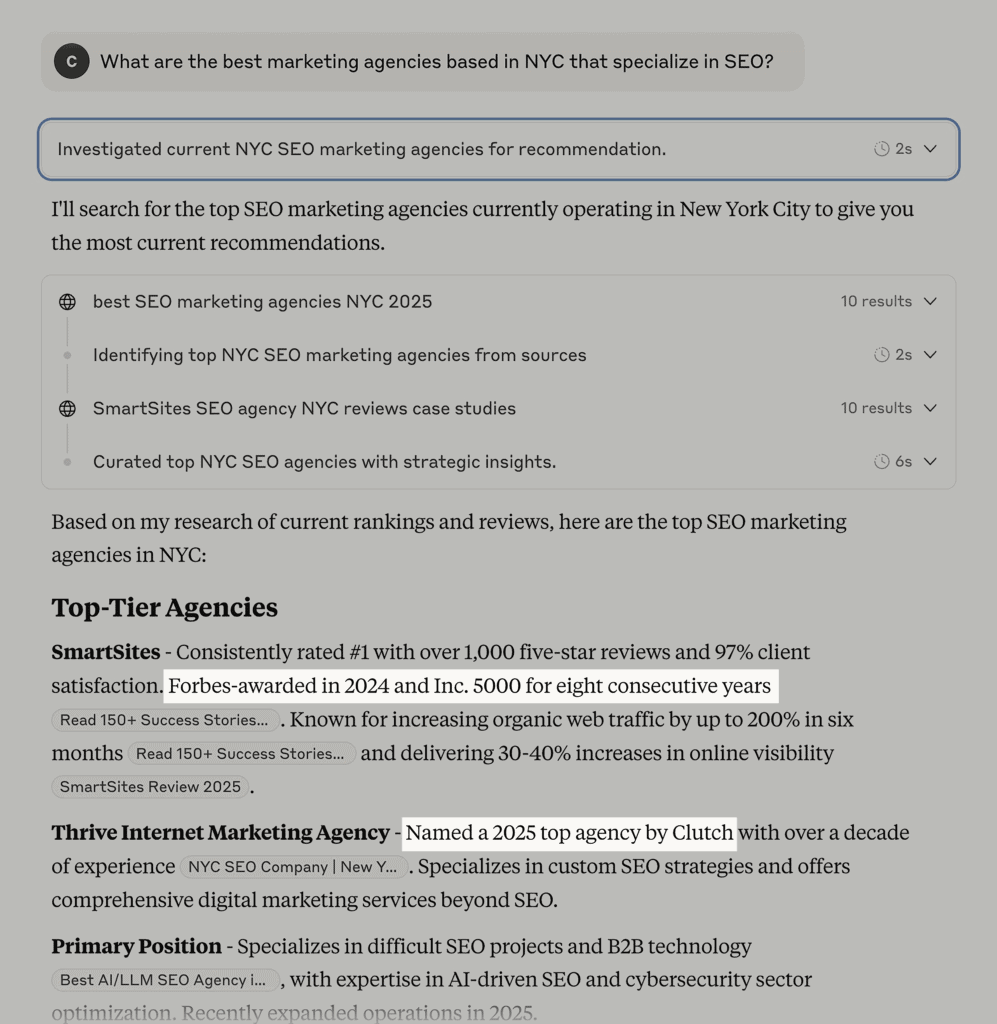
What Isn’t Changing
The fundamentals of marketing your professional services, whether you’re an agency, consultant, or freelancer, still drive AI recommendations.
Creating content, running ad campaigns, and social media marketing are all still valid ways to attract leads.
And turning them into paying clients will still depend on how well you package your offering — and the quality of services you offer.
Further reading: The Best SEO Software for Agencies to Scale Your Workflows
Content Creators & Publishers
Impact level: High
Important tactics: Showing your expertise, structuring content for LLMs, and multi-format optimization
The impact on content creators and publishers is likely going to be the highest on this list, simply because they tend to focus on informational content.
We’re talking blogs and major publisher sites — the kind that post a lot of content like:
- What Is X
- X vs. Y
- How to Z
If an AI summary can answer your user’s query well enough, the user is never going to need to click through to your site. So no matter how well these sites optimize for GEO, there’s going to be a traffic impact.
But that doesn’t mean you should sit back and admit defeat. Instead, optimizing for GEO and AI visibility in general is just going to be even more important.
What Matters Most Now
How can you stay ahead as a publisher? By providing something other people can’t, structuring your content with AI tools in mind, and taking a multi-platform approach.
It takes time, effort, and possibly investment, too. But it’s a must if you want to turn previous SEO success into future generative engine optimization wins.
Here’s how to do it:
Lean on Your Own Data and Experience
AI engines love content backed by real data and firsthand experience. They prioritize sources that provide specific, verifiable information over generic advice.
Just telling readers that “email marketing can increase sales” isn’t enough. You need to show the numbers, ideally from your own firsthand experience.
So, you might write “our email campaign generated $226,000 in sales from 11,000 subscribers in two weeks,” instead.
AI engines can cite these specific figures. And users who see these numbers cited in AI responses are more likely to click through to your content to learn more.
You can also run studies, surveys, or experiments in your niche. This kind of originality is likely to get picked up by AI tools.
For example, the Backlinko team recently ran an experiment to see if ChatGPT is using Google Search.
And Google’s AI Mode picked up this experiment in its response for a related query:
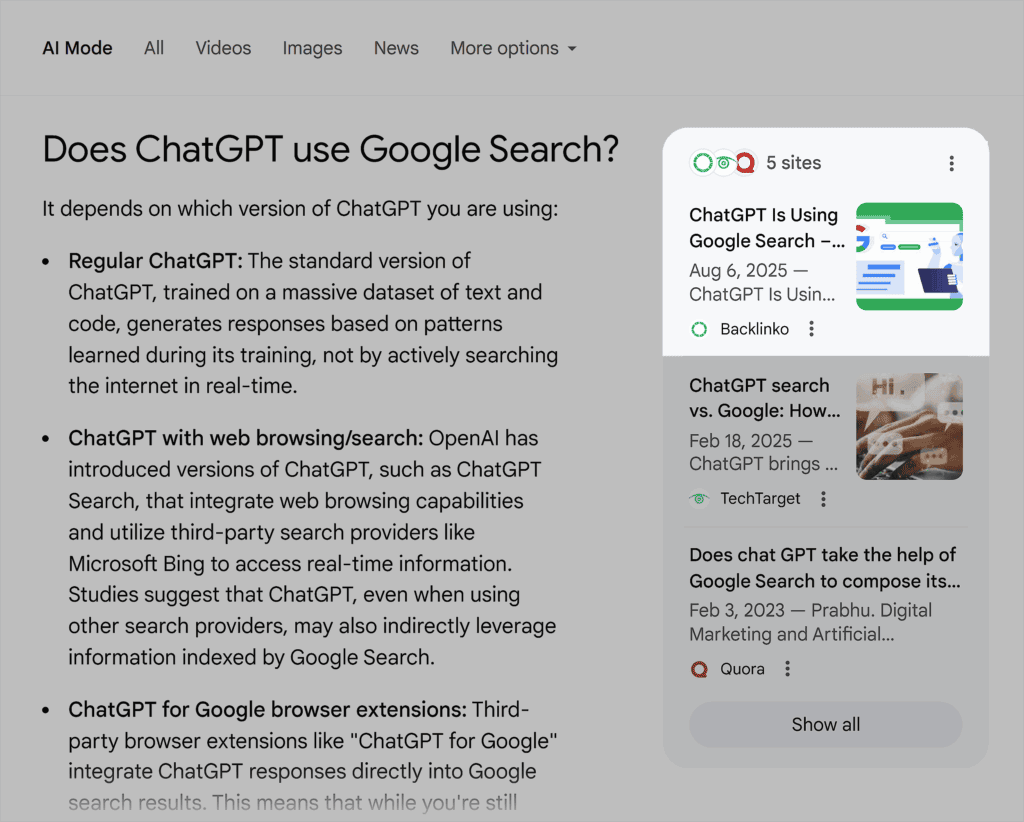
When AI systems cite you as a source, it signals credibility to users, boosting brand awareness and driving branded searches or direct traffic.
As others pick up and reference your research online, it creates a positive feedback loop: more citations strengthen your authority, which in turn makes AI tools even more likely to recommend your content.
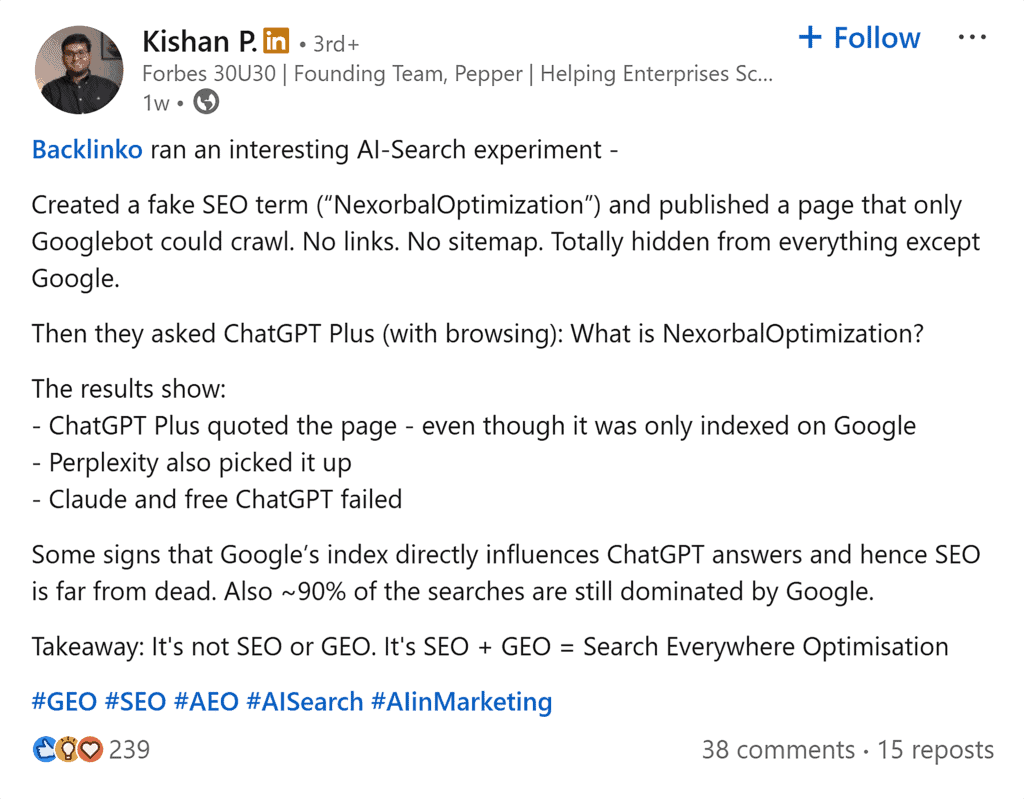
For more on how you can infuse originality into your content, check out this guide on information gain.
Structure Your Content with AI in Mind
AI engines parse content differently than humans read it. They look for clear patterns, structured data, and easy-to-extract information.
You can make your content easier for AI tools to understand (and cite) by:
- Using descriptive headings
- Adding FAQ sections where useful and relevant (don’t just spam them in every article)
- Including pros and cons sections
- Using tables and lists to add structure
- Writing in short sentences and paragraphs
Use a Multi-Platform Strategy
Optimizing for traditional organic Google search is simply not going to be viable in an AI era.
Not just because AI Overviews are answering questions for users…
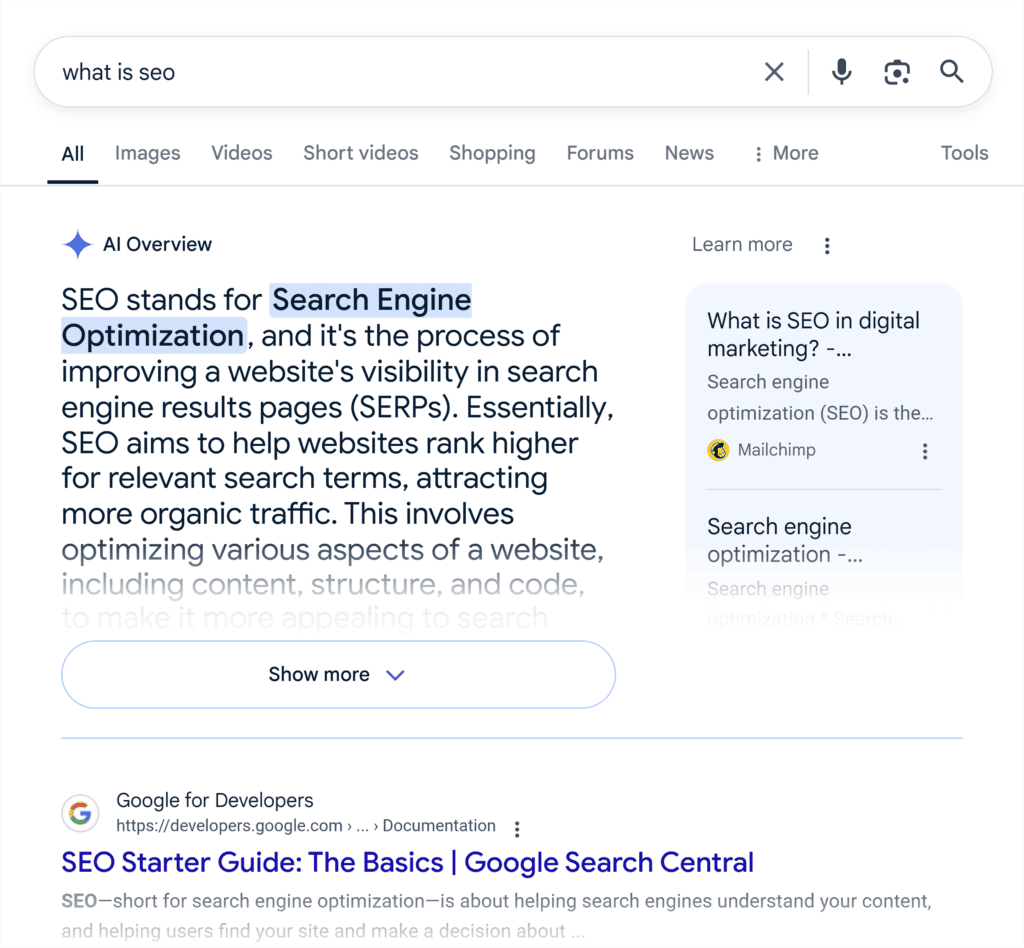
…but because Google’s AI Mode is redefining what “search” itself looks like:
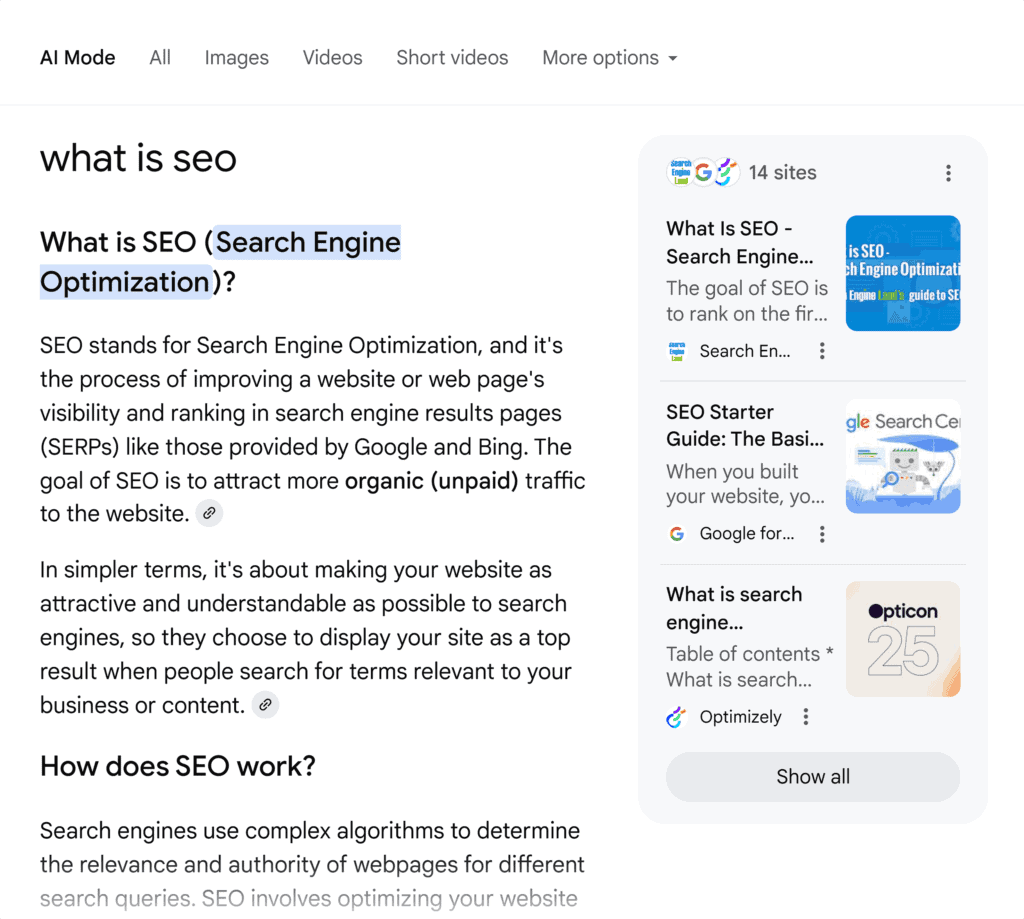
And Semrush data suggests LLM traffic will exceed traditional organic search traffic by early 2028:
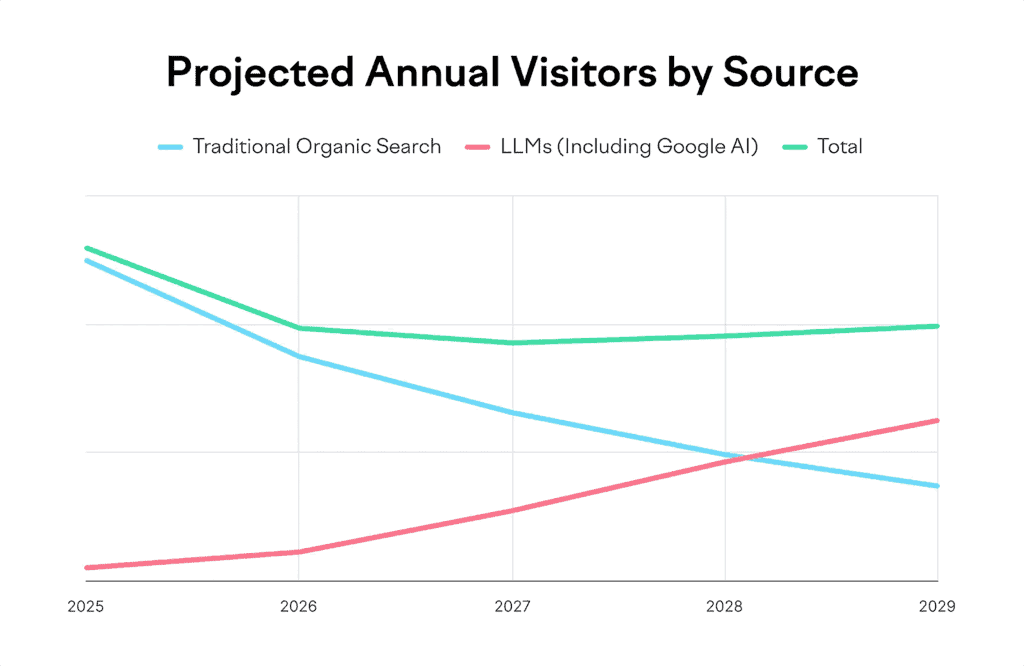
That means, aside from optimizing for these AI responses, you need to expand beyond Google as a platform.
So where should you post?
One option is YouTube. It has long been one of the top search engines, and it has also long been a very useful marketing channel for brands and publishers.
Expanding into video lets you reach a new audience on a platform that is unlikely to be as affected by LLMs as search (at least for now).
Plus, AI tools often cite YouTube videos in their answers:
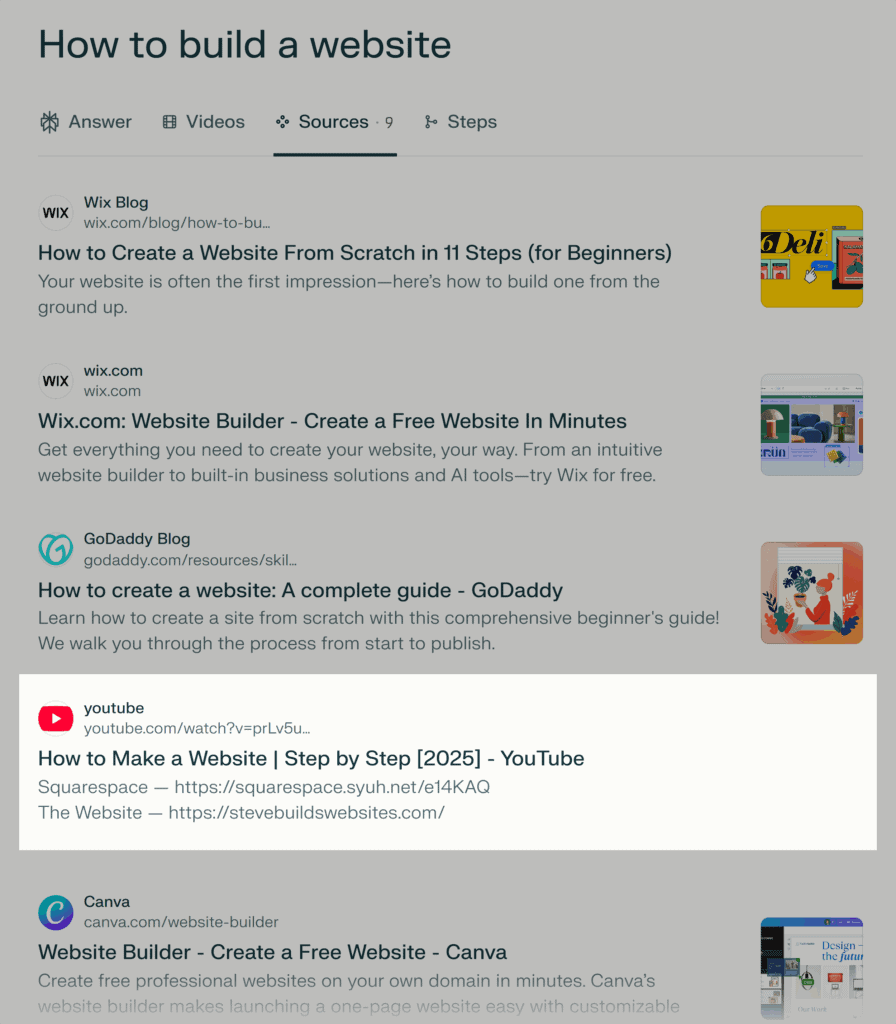
This means not only are you diversifying and expanding your audience — you’re also optimizing for generative engines at the same time.
But video isn’t the only route.
Social media is another arena where publishers and bloggers can win big in the GEO era.
Again, you’re not just expanding your potential audience. You also give yourself a chance to build a following and a connection with that following that blogging alone can’t achieve.
Pro tip: Find out which platforms you should target using a tool like Semrush’s Audience Intelligence app.
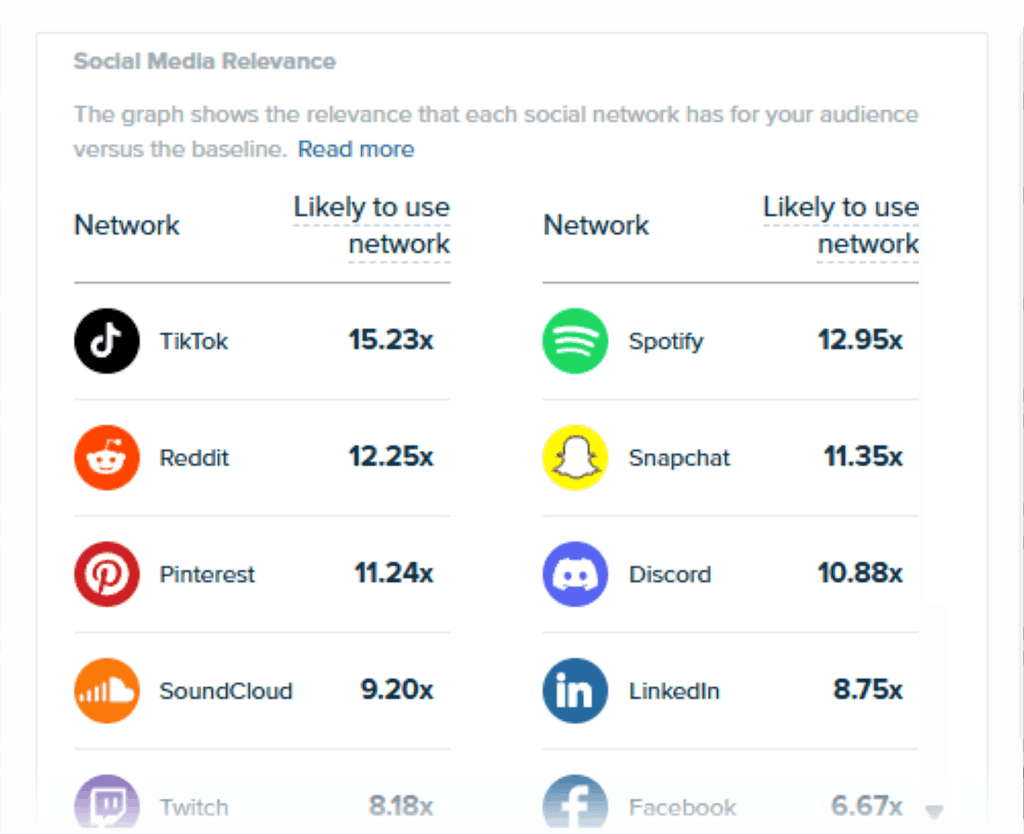
What Isn’t Changing
High-quality content is still the cornerstone of a blog or publisher’s overall strategy.
You still need to show up consistently, give your readers what they want, and provide something they can’t get elsewhere.
AI tools also rely on content to provide to users. And they still need to cite:
- Unique voices with firsthand experience (think E-E-A-T from traditional SEO)
- Data and studies
- Expert insights
- Up-to-date information
These are all aspects of great content that AI on its own can’t replicate. Which means there’s still an important place for blogs and content sites in the GEO era.
Local Service Businesses
Impact level: Low
Important tactics: Website optimization and local listings
The impact of GEO on local service businesses is likely to be lower than in other industries.
That’s because how people search for and interact with local businesses isn’t likely to change a whole lot — the user still needs to make a call or send an email.
Plus, most local business owners have long focused on service and location-based keywords.
So they’re not likely to be impacted by AI summaries of long-tail, top-of-the-funnel keywords (like a blogger might be, for example).
But GEO is shifting the focus, and there are a few key ways you can prepare your business for this shift.
What Matters Most Now
A lot of what local businesses need to do to optimize for AI is just good local SEO. But here are two specific things to focus on:
Keep Your Website Up to Date
Google relies heavily on its Google Business Profile (GBP) listings when ranking and displaying results for local searches.
But AI tools like ChatGPT tend to look at business websites instead:
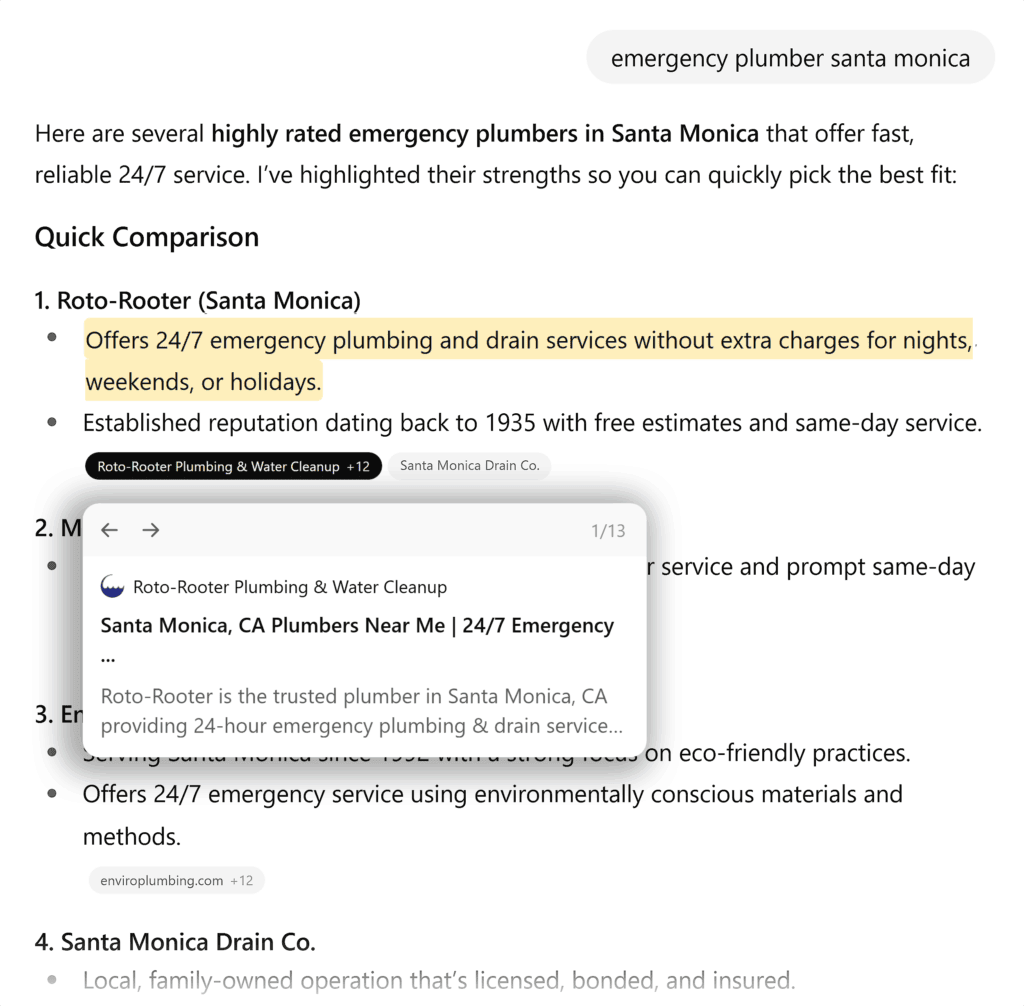
They can use your website to pull information like fees, days you operate, benefits you offer, and more.
This is often more in-depth than users see in Google’s local pack, for example:
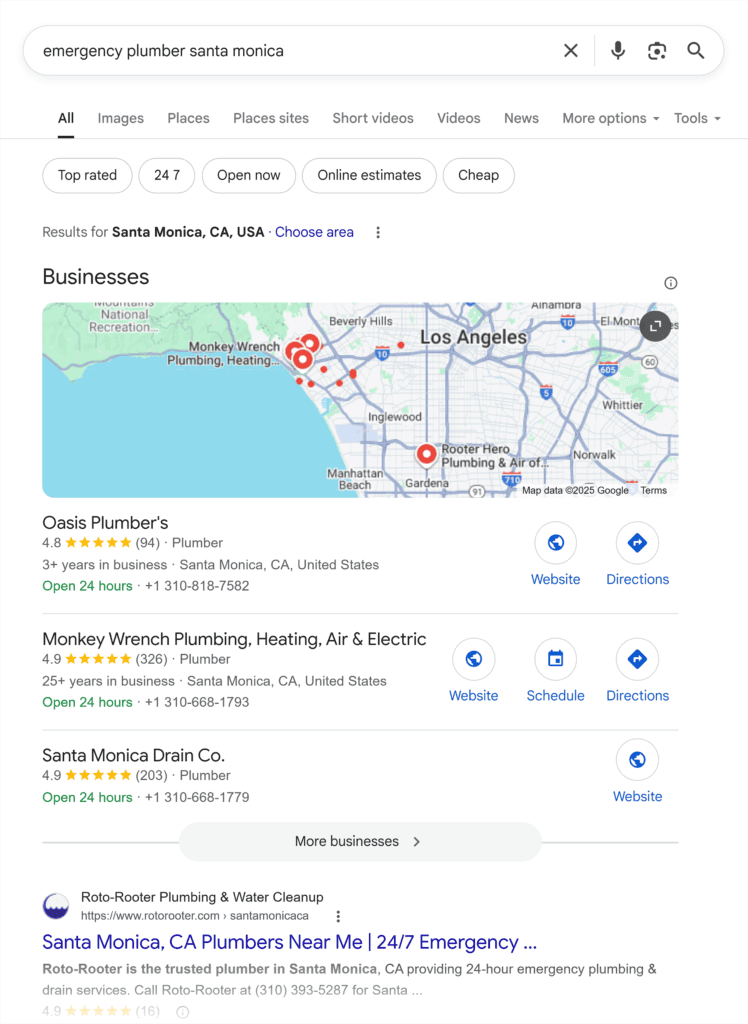
So while having an optimized business website has always been a good idea, it’s even more important if you want to appear in AI responses.
And if you want the information that appears in these responses to be convincing enough to help potential customers choose you.
It’s worth noting, though, that the way AI tools present local search results varies a lot by query, and they’ll continue to evolve.
But right now, these tools are pulling a lot of info from business websites specifically.
Here’s a quick-fire checklist to optimize yours:
- Make it clear what you do, where you offer your services, and any unique selling points of your business
- Add key business details to your footer (like your phone number, address, and opening hours)
- Include your city/region naturally in your page titles, headers, and content
- Create optimized location and/or service-specific pages
- Include customer reviews and testimonials throughout your site
Get Listed in Directories
Beyond business-specific websites, AI tools also look at listing sites like Yelp:
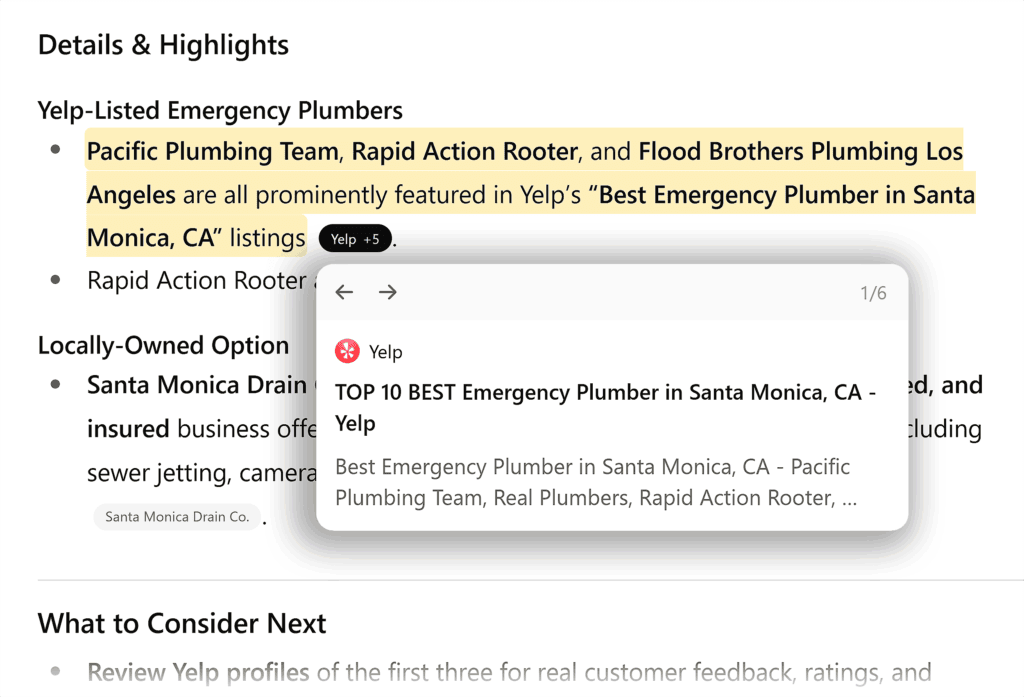
This means, like with local SEO, a solid local GEO strategy involves getting and optimizing your listings on major directory sites.
Think:
- Yelp
- Foursquare
- BBB
- Angi
- Trustpilot
Pro tip: Semrush’s Listing Management tool lets you monitor and optimize all your local listings in one place.
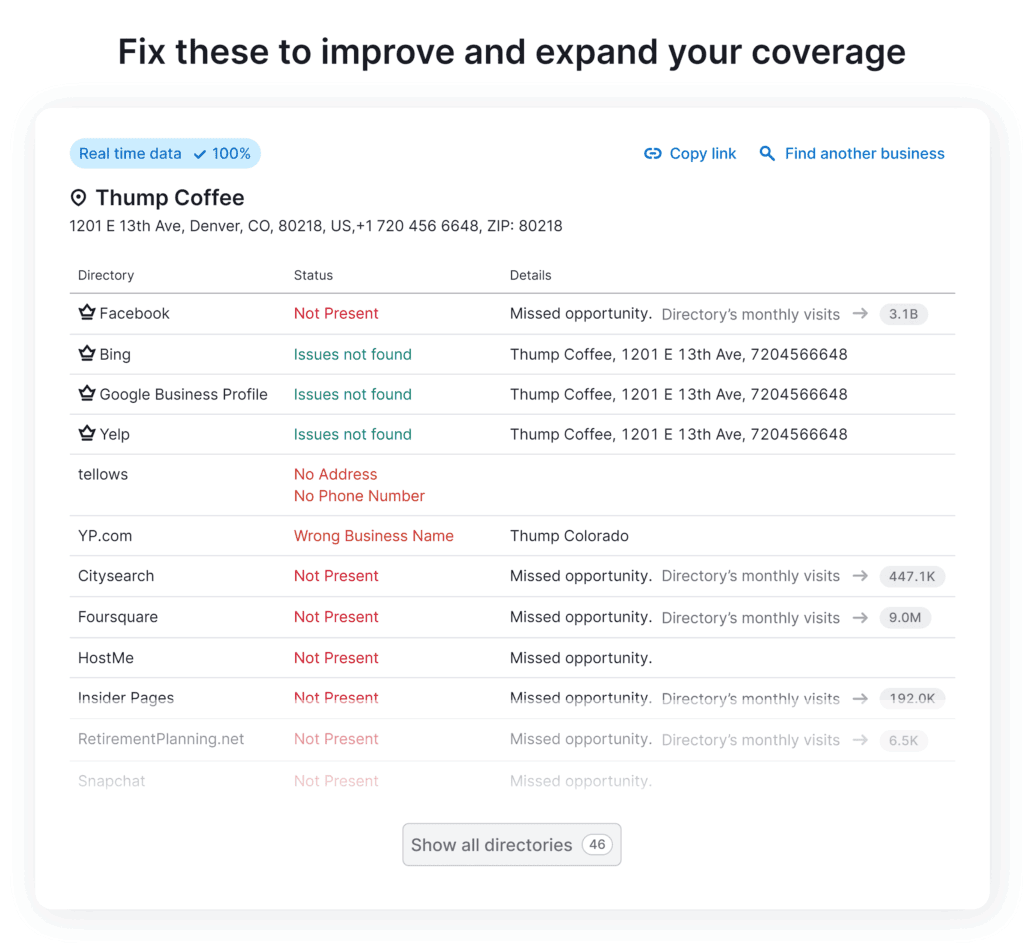
What Isn’t Changing
The good news is that somebody searching for a service business still needs that service business. AI tools can’t fix their leaky pipe or give them a dental checkup. So generative engine optimization isn’t likely to impact traffic as much as it might for a content-focused website.
As long as your business shows up in generative results, you should still be able to attract leads, grow your customer base, and drive revenue.
And you still need to:
- Provide a great customer experience
- Encourage reviews and testimonials
- Make it easy for potential customers to sign up, call you, or book an appointment
GEO changes some of how you approach digital marketing as a small business. But it doesn’t change these critical aspects.
Tailor Your Generative Engine Optimization Strategy to Your Business
The shift from traditional search to AI search will impact all businesses. But how it impacts yours and what you need to do to prepare for this shift depends on:
- Your business model
- Your industry
- How you find new customers
To understand how this shift is affecting your business, and to keep track of your AI mentions, use one of our recommended AI visibility tools.